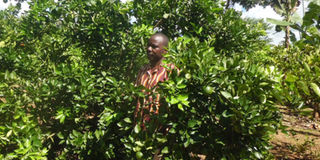How to manage citrus fruits during covid-19 lockdown

A farmer checks for pests in his orange ochard. Photo by Lominda Afedraru
Since the announcement of the Covid-19 pandemic across the globe including Uganda, people resorted to consuming food nutrients capable of building body immunity.
Some of the types of food which became hot cake in the open market include citrus fruits, vegetables and fortified foods rich in Vitamin A, Beta Carotene, zinc and Iron.
A walk in Nakawa Market one Monday morning, led to an experience of a flood of food vendors concentrating on sale of citrus fruits and in particular lemon whose demand has grown so high leading to an escalation in price.
A small basket of lemons at Nakawa containing four lemons on average will cost you Shs2,000. The same before Covid - 19 would go for Shs1,000.
However since the demand for citrus fruits has grown rapidly, this therefore calls for farmers to boost their energy by tending to the citrus farms well and observe the best agronomy practice to get bumper harvest.
This includes management of the pests and diseases which is a major challenge to citrus fruit farmers who are mainly growing the plant in eastern Uganda.
Common fruits
Most fruit farmers grow oranges (Valencia, Navel and sweet orange citrus sinensis). Others grow lemon namely Eureka and Meyer varieties rich in vitamin C.
These fruit varieties according to experts are rich in plant compounds with health benefits resulting into anti-inflammatory and antioxidant effects.
These fruits are also a good source of fibre which helps in digestion and weight loss and it helps in reducing kidney stones arising from lower citrate levels in the urine.
The fruits contain narongin an oxidant which keeps the heart healthy and keeps the brain healthy from neurodegenetive diseases.
Lemons in particular help to ease throat congestion and soothes it for someone suffering from common cold and is recommended as natural treatment measure.
Pests and diseases
In a 2018 publication in the Journal of Entomology and Zoology Studies about distribution, abundance and severity of citrus pests in northern Uganda, it is stated that Brazil, United States and China continue to be the three largest processed orange producing regions in the world taking up 85 per cent of the market.
It is stated that in East Africa, citrus production is estimated at 10 tonnes per hectare below the demand and the expected yield of 50 to 70 tonnes per hectare.
However, the decline in production by these countries is attributed to pests and diseases, despite the immense potential to export to the European Union.
As such there is a concerted effort by stakeholders in a bid to help farmers address the challenge of pests and diseases.
One such effort is at National Agricultural Research Organisation (Naro) who are carrying out management of citrus fruit farming and evaluating pest and diseases affecting the fruit in eastern Uganda.
The project is in its third phase funded under the Korea Programme on International Agriculture (Kopia) Uganda to a tune of $30,000 per year.
Common pests and diseases
The most common disease is the Pseudocercospora fruit and leaf spot, which destroys the fruits and leaves.
There is also altrenario brown spot, which usually causes a dark spot on the fruit, and Anthracnose, which causes hard black spots on the fruit.
The pests include aphids which attack the tree by sucking the sap out of the leaves. Scales insects cause leaves to yellow leading to early shedding. The other pests include larvae, fruit flies and orange dogs which affects the fruit.
The pest and disease challenge may arise due to climatic conditions including water stress in the fields and poor management practices.
Naro has set up disease management experiments in Kaberamaido, Bukedea and Kumi districts and soil water management experiments set up in Soroti and Ngora.
Challenges
Farmers have challenges accessing inputs and these calls for intervention of cooperative unions.
There is the challenge of poor markets and marketing arrangements leading to farmers in districts of Kaberamaido, Kumi and Bukedea sometimes selling 100 kilogrammes of the fruit at Shs30,000.
The Deputy Director Naro Dr Imelda Kashaija, pointed out that such initiatives to combat pests and diseases is good because climate change effects are so rampant and affecting farmers.
To her application of simply technologies as demonstrated by the scientists in citrus value chain are to improve farmer’s productivity leading to improved household incomes.
Crop management
Farmers have also been trained in plant management including pesticide use, timely pruning, identification of soil fertility and spacing.
Other measures include thinning, scouting, correct planting period, proper sanitation, fertiliser use and cover cropping.
Soil management
Farmers are expected to carry out mulching, dig ridges, shallow trenches/channels to absorb water in the fields during dry season. Roadside water harvesting, use water basins for trapping rain water in the soil and application of manure at the appropriate time.
Farmers who are adopting these management practices are realising better performing citrus crop with more green leaves, bigger fruit yields above the normal fruit size of 53mm in diameter.




